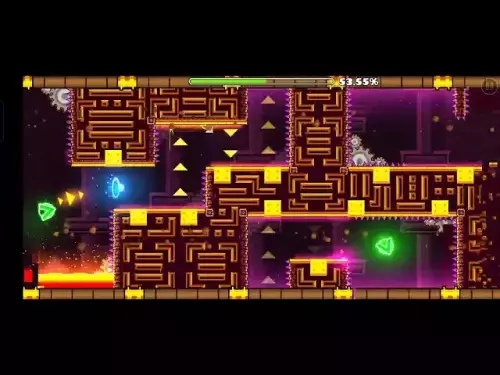-
 bitcoin
bitcoin $109547.008142 USD
0.04% -
 ethereum
ethereum $4011.838726 USD
-0.05% -
 tether
tether $1.000402 USD
-0.01% -
 xrp
xrp $2.798606 USD
0.88% -
 bnb
bnb $970.877944 USD
1.39% -
 solana
solana $202.237275 USD
-0.95% -
 usd-coin
usd-coin $0.999673 USD
0.00% -
 dogecoin
dogecoin $0.229294 USD
-1.15% -
 tron
tron $0.336370 USD
-0.45% -
 cardano
cardano $0.777260 USD
-1.66% -
 hyperliquid
hyperliquid $45.503019 USD
1.73% -
 ethena-usde
ethena-usde $1.000362 USD
0.01% -
 chainlink
chainlink $20.785303 USD
-1.10% -
 avalanche
avalanche $28.755822 USD
-0.11% -
 stellar
stellar $0.358303 USD
-0.48%
What Is a Candlestick Chart Pattern in Day Trading?
By analyzing candlestick chart patterns, day traders can identify potential reversal points, continuation signals, and consolidation periods.
Oct 27, 2024 at 01:44 am

Understanding Candlestick Chart Patterns in Day Trading
Candlestick charts are a widely used technical analysis tool in day trading. They provide a visual representation of price movements over a specific time period, typically ranging from one minute to one day. Each candlestick consists of:
- Open Price: The price at which the asset was opened during the timeframe represented by the candlestick.
- Close Price: The price at which the asset closed during the timeframe.
- High Price: The highest price reached during the timeframe.
- Low Price: The lowest price reached during the timeframe.
By analyzing the patterns formed by candlesticks, traders can gain valuable insights into the market's behavior and predict future price movements. Here are some common candlestick chart patterns used in day trading:
Bullish Patterns
1. Bullish Engulfing: A long green candle that completely engulfs the previous red candle, indicating a reversal from a downtrend to an uptrend.2. Bullish Hammer: A candle with a small body and a long lower shadow, forming a "hammer" shape. It suggests that buyers have entered the market, pushing prices higher.3. Ascending Triangle: A pattern characterized by higher lows and resistance at a horizontal level. It can indicate an upward breakout once the resistance is broken.4. Bullish Flag: A consolidation pattern formed after a strong uptrend, resembling a rectangular flag with a slight downward slope. It typically precedes a breakout and continuation of the uptrend.
Bearish Patterns
1. Bearish Engulfing: A long red candle that completely engulfs the previous green candle, signaling a reversal from an uptrend to a downtrend.2. Bearish Hanging Man: A candle with a small body and a long lower shadow, forming a "hanging man" shape. It implies that sellers are gaining momentum.3. Descending Triangle: A pattern characterized by lower highs and support at a horizontal level. It can indicate a downward breakout once the support is violated.4. Bearish Pennant: A consolidation pattern formed after a strong downtrend, resembling a triangular flag with a slight upward slope. It often precedes a breakout and continuation of the downtrend.
Neutral Patterns
1. Doji: A candle with an open and close price that are almost identical, forming a cross or small line. Dojis can indicate indecision in the market and may lead to either a reversal or continuation of the current trend.2. Harami: A small candle that is completely contained within the previous candle. Haramis can indicate a pause in the trend or a potential reversal.3. Three Inside Up/Down: Three consecutive candles that are completely contained within the opening and closing prices of the first candle. They can signal a continuation of the trend.
Tips for Using Candlestick Chart Patterns in Day Trading
- Use multiple candlestick patterns in conjunction with each other to enhance accuracy.
- Consider the context of the overall market conditions, including volume and other technical indicators.
- Set appropriate stop-loss orders to manage risk and protect profits.
- Be aware of false breakouts or reversals that can mislead traders.
- Practice using candlestick chart patterns in a simulated trading environment before applying them in the live market.
Disclaimer:info@kdj.com
The information provided is not trading advice. kdj.com does not assume any responsibility for any investments made based on the information provided in this article. Cryptocurrencies are highly volatile and it is highly recommended that you invest with caution after thorough research!
If you believe that the content used on this website infringes your copyright, please contact us immediately (info@kdj.com) and we will delete it promptly.
- Crypto Whales, PEPE, and Meme Coins: What's the Hype?
- 2025-09-28 18:25:15
- Cathie Wood, Hyperliquid, and Solana Development: A New Era in Crypto?
- 2025-09-28 19:05:16
- Polkadot pUSD: NYC's Take on Decentralized Stability
- 2025-09-28 18:25:15
- Chainlink, Remittix, and Price Gains: A Tale of Two Cryptos
- 2025-09-28 19:05:16
- Altcoins, Portfolios, and Millions: Decoding the Crypto Bull Run
- 2025-09-28 19:10:01
- SWIFT, Ethereum, and Linea: Revolutionizing Global Banking?
- 2025-09-28 18:30:01
Related knowledge

Practical parameter settings for a Bitcoin multi-timeframe moving average system
Sep 18,2025 at 10:54pm
Optimizing Timeframe Combinations for Bitcoin Trading1. Selecting appropriate timeframes is crucial when building a multi-timeframe moving average sys...

How can I filter out false breakouts in Dogecoin high-frequency trading?
Sep 22,2025 at 01:00am
Understanding False Breakouts in Dogecoin Trading1. A false breakout occurs when Dogecoin's price appears to move beyond a defined support or resistan...

Techniques for identifying tops and bottoms in the Bitcoin on-chain NVT model
Sep 20,2025 at 07:54pm
Understanding the NVT Model in Bitcoin Analysis1. The Network Value to Transactions (NVT) ratio is often described as the 'P/E ratio' of the cryptocur...

What does the surge in open interest in Bitcoincoin futures mean?
Sep 20,2025 at 11:18pm
Understanding the Surge in Dogecoin Futures Open Interest1. A surge in open interest within Dogecoin futures indicates a growing number of active cont...

How can I use the Ethereum USDT premium to gauge market sentiment?
Sep 18,2025 at 11:55pm
Understanding the Ethereum USDT Premium1. The Ethereum USDT premium refers to the price difference between USDT (Tether) traded on Ethereum-based plat...

What should I do if Ethereum staking yields decline?
Sep 20,2025 at 06:18am
Understanding the Causes Behind Declining Ethereum Staking Yields1. The Ethereum network transitioned to a proof-of-stake consensus mechanism with the...

Practical parameter settings for a Bitcoin multi-timeframe moving average system
Sep 18,2025 at 10:54pm
Optimizing Timeframe Combinations for Bitcoin Trading1. Selecting appropriate timeframes is crucial when building a multi-timeframe moving average sys...

How can I filter out false breakouts in Dogecoin high-frequency trading?
Sep 22,2025 at 01:00am
Understanding False Breakouts in Dogecoin Trading1. A false breakout occurs when Dogecoin's price appears to move beyond a defined support or resistan...

Techniques for identifying tops and bottoms in the Bitcoin on-chain NVT model
Sep 20,2025 at 07:54pm
Understanding the NVT Model in Bitcoin Analysis1. The Network Value to Transactions (NVT) ratio is often described as the 'P/E ratio' of the cryptocur...

What does the surge in open interest in Bitcoincoin futures mean?
Sep 20,2025 at 11:18pm
Understanding the Surge in Dogecoin Futures Open Interest1. A surge in open interest within Dogecoin futures indicates a growing number of active cont...

How can I use the Ethereum USDT premium to gauge market sentiment?
Sep 18,2025 at 11:55pm
Understanding the Ethereum USDT Premium1. The Ethereum USDT premium refers to the price difference between USDT (Tether) traded on Ethereum-based plat...

What should I do if Ethereum staking yields decline?
Sep 20,2025 at 06:18am
Understanding the Causes Behind Declining Ethereum Staking Yields1. The Ethereum network transitioned to a proof-of-stake consensus mechanism with the...
See all articles









































































